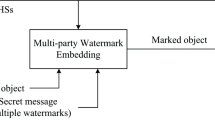Abstract
Many algorithms which mark data in order to enforce copyright protection have recently been proposed. Among these, the family of spread-spectrum based schemes is predominant. This family has an inherent weakness when used to mark several documents: either it changes the key for each document and has to maintain a complex database of keys or it uses the same key for every document and will face collusion attacks. In this paper, we propose a new blind scheme, which embeds different marks in different documents, but allows detection with the help of a single private key. Our scheme can be used on top of most existing spread spectrum based schemes, and is much less prone to collusion attacks than the latters. We also prove that the false positive and false negative detection rates of our protocol are exponentially small. Finally, we believe the mathematical tools used in this article to prove concentration of random variables around their means will be useful for analyzing other watermarking schemes, and that they will be of further use for other problems in cryptology.
Access this chapter
Tax calculation will be finalised at checkout
Purchases are for personal use only
Preview
Unable to display preview. Download preview PDF.
Similar content being viewed by others
References
J. Boeuf and J. P. Stern. An analysis of one of the SDMI candidates. These proceedings.
I. Cox, J. Kilian, F. T. Leighton, and T. Shamoon. Secure spread spectrum watermarking for images, audio and video. In IEEE Int. Conference on Image Processing, volume 3, pages 243–246, 1996.
I. J. Cox, J.Kilian, T.Leighton, and T.Shamoon. A secure, robust watermark for multimedia. In Ross Anderson, editor, Workshop on Information Hiding, number 1174 in Lecture Notes in Computer Science. Springer-Verlag, 1996.
Ingemar J. Cox and Matt L. Miller. A review of watermarking anf the importance of perceptual modeling. In Proc. of Electronic Imagining’ 97, 1997.
J. Eggers, J. Su, and B. Girod. Asymmetric watermarking schemes. In Sicherheit en Mediendeten, 2000.
J. Eggers, J. Su, and B. Girod. Public key watermarking by eigenvectors of linear transforms. In EUSIPCO, 2000.
T. Furon and P. Duhamel. An asymmetric public detection watermarking technique. In IH99, pages 88–100, 1999.
T. Furon and P. Duhamel. Robustness of an asymmetric technique. In ICIP 2000, 2000.
T. Furon, I. Venturini, and P. Duhamel. A unified approach of asymmetric schemes. In E. Delp and P. Wah Wong, editors, Security and Watermarking of Multimedia Contents, number 4312 in Proceedings of SPIE. SPIE, 2001.
F. Hartung and B. Girod. Digital watermarking of raw and compressed video. In SPIE 2952: Digital Compression Technologies and Systems for Video Communication, pages 205–213, 1996.
N. F. Johnson, Z. Duric, and S. Jajodia. Recovery of watermarks from distorted images. In Andreas Pfitzmann, editor, Information Hiding Workshop’ 99, Lecture Notes in Computer Science, pages 318–332. Springer-Verlag, 1999.
F. A. P. Petitcolas, R. J. Anderson, and M. G. Kuhn. Attacks on copyright marking systems. In David Aucsmith, editor, Second Workshop on Information Hiding, number 1525 in Lecture Notes in Computer Science, pages 218–238. Springer-Verlag, 1998.
S. Perreira and T. Pun. Fast robust template matching for affine resistant image watermarks. In Andreas Pfitzmann, editor, Information Hiding Workshop’ 99, Lecture Notes in Computer Science, pages 199–210. Springer-Verlag, 1999.
B. Pfitzmann and M. Schunter. Asymmetric fingerprinting (extended abstract). In Ueli Maurer, editor, Advances in Cryptology-Eurocrypt 96, number 1070 in Lecture Notes in Computer Science, pages 84–95. Springer-Verlag, 1996.
R. L. Pickholtz, D. L. Schilling, and L. B. Millstein. Theory of spread spectrum communications — a tutorial. In IEEE Trans. on Communications, pages 855–884, 1982.
B. Pfitzmann and M. Waidner. Asymmetric fingerprinting for larger collusions. In 4th ACM Conference on Computer and Communications Security, pages 151–160, 1997.
J. Smith and C. Dodge. Develoments in steganography. In Andreas Pfitzmann, editor, Third Workshop on Information Hiding, number 1768 in Lecture Notes in Computer Science, pages 77–87. Springer-Verlag, 1999.
J. P. Stern and J-P. Tillich. Automatic detection of a watermarked document using a single private key. full version. http://www.julienstern.org/files/detection/
R. Van Schyndel, A. Tirkel, and I. Svalbe. Key independent watermark detection. Int. Conf. on Multimedia Computing and Systmes. volume 1, 1999.
Author information
Authors and Affiliations
Editor information
Editors and Affiliations
Rights and permissions
Copyright information
© 2001 Springer-Verlag Berlin Heidelberg
About this paper
Cite this paper
Stern, J.P., Tillich, JP. (2001). Automatic Detection of a Watermarked Document Using a Private Key. In: Moskowitz, I.S. (eds) Information Hiding. IH 2001. Lecture Notes in Computer Science, vol 2137. Springer, Berlin, Heidelberg. https://doi.org/10.1007/3-540-45496-9_19
Download citation
DOI: https://doi.org/10.1007/3-540-45496-9_19
Published:
Publisher Name: Springer, Berlin, Heidelberg
Print ISBN: 978-3-540-42733-9
Online ISBN: 978-3-540-45496-0
eBook Packages: Springer Book Archive




